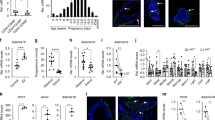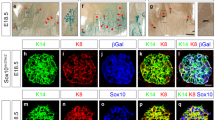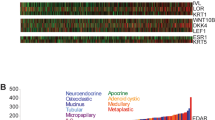Abstract
Syndecan-1 is a cell-surface, heparan-sulphate proteoglycan (HSPG) predominantly expressed by epithelial cells. It binds specifically to many proteins, including oncoproteins. For example, it induces the assembly of a signalling complex between FGF ligands and their cognate receptors1. But so far there has been no direct evidence that this proteoglycan contributes to tumorigenesis. Here we have examined the role of syndecan-1 (encoded by Sdc1) during mammary tumour formation in response to the ectopic expression of the proto-oncogene Wnt1. We crossed syndecan-1–deficient mice with transgenic mice that express Wnt1 in mammary gland (TgN(Wnt-1)1Hev; ref. 2). Ectopic Wnt-1 expression induces generalized mammary hyperplasia, followed by the development of solitary tumours (median time 22 weeks3). We show that in Sdc1−/− mice, Wnt-1–induced hyperplasia in virgin mammary gland was reduced by 70%, indicating that the Wnt-1 signalling pathway was inhibited. Of the 39 tumours that developed in a test cohort of mice, only 1 evolved in the Sdc1−/− background. In addition, we show that soluble syndecan-1 ectodomain purified from mouse mammary epithelial cells stimulates the activity of a Wnt-1 homologue in a tissue culture assay. Our results provide both genetic and biochemical evidence that syndecan-1 can modulate Wnt signalling, and is critical for Wnt-1–induced tumorigenesis of the mouse mammary gland.
This is a preview of subscription content, access via your institution
Access options
Subscribe to this journal
Receive 12 print issues and online access
$209.00 per year
only $17.42 per issue
Buy this article
- Purchase on Springer Link
- Instant access to full article PDF
Prices may be subject to local taxes which are calculated during checkout




Similar content being viewed by others
References
Bernfield, M. et al. Functions of cell surface heparan sulfate proteoglycans. Annu. Rev. Biochem. 68, 729–777 (1999).
Tsukamoto, A.S., Grosschedl, R., Guzman, R.C., Parslow, T. & Varmus, H.E. Expression of the int-1 gene in transgenic mice is associated with mammary gland hyperplasia and adenocarcinomas in male and female mice. Cell 55, 619–625 (1988).
Shackleford, G.M., MacArthur, C.A., Kwan, H.C. & Varmus, H.E. Mouse mammary tumor virus infection accelerates mammary carcinogenesis in Wnt-1 transgenic mice by insertional activation of int-2/Fgf-3 and hst/Fgf-4. Proc. Natl Acad. Sci. USA 90, 740–744 (1993).
Bernfield, M. et al. Biology of the syndecans: a family of transmembrane heparan sulfate proteoglycans. Annu. Rev. Cell Biol. 8, 365–393 (1992).
Kato, M., Saunders, S., Nguyen, H. & Bernfield, M. Loss of cell surface syndecan-1 causes epithelia to transform into anchorage-independent mesenchyme-like cells. Mol. Biol. Cell 6, 559–576 (1995).
Cardiff, R.D. & Wellings, S.R. The comparative pathology of human and mouse mammary glands. J. Mammary Gland Biol. Neoplasia 4, 105–122 (1999).
Lee, F.S., Lane, T.F., Kuo, A., Shackleford, G.M. & Leder, P. Insertional mutagenesis identifies a member of the Wnt gene family as a candidate oncogene in the mammary epithelium of int-2/FGF-3 transgenic mice. Proc. Natl Acad. Sci USA 92, 2268–2272 (1995).
Brown, A.M.C., Wildin, R.S., Prendergast, T.J. & Varmus, H.E. A retrovirus vector expressing the putative mammary oncogene int-1 causes partial transformation of a mammary epithelial cell line. Cell 46, 1001–1009 (1986).
Shimizu, H. et al. Transformation by Wnt family proteins correlates with regulation of β-catenin. Cell Growth Differ. 8, 1349–1358 (1997).
Uren, A. et al. Secreted Frizzled related protein sFRP-1 binds directly to Wingless and is a biphasic modulator of Wnt signaling. J. Biol. Chem. 275, 4374–4382 (2000).
Reichsman, F., Smith, L. & Cumberledge, S. Glycosaminoglycans can modulate extracellular localization of the wingless protein and promote signal transduction. J. Cell Biol. 135, 819–827 (1996).
Conrad, H.E. Heparin-Binding Proteins (Academic, London, 1998).
Bradley, R.S. & Brown, A.M.C. The proto-oncogene int-1 encodes a secreted protein associated with the extracellular matrix. EMBO J. 9, 1569–1575 (1990).
Burrus, L.W. & McMahon, A.P. Biochemical analysis of murine Wnt proteins reveals both shared and distinct properties. Exp. Cell Res. 220, 363–373 (1995).
Jue, S.F., Bradley, R.S., Rudnicki, J.A., Varmus, H.E. & Brown, A.M.C. The mouse Wnt-1 gene can act via a paracrine mechanism in transformation of mammary epithelial cells. Mol. Cell. Biol. 12, 321–328 (1992).
Haerry, T.E., Heslip, T.R., Marsh, J.L. & O'Connor, M.B. Defects in glucuronate biosynthesis disrupt Wingless signaling in Drosophila. Development 124, 3055–3064 (1997).
Hacker, U., Lin, X. & Perrimon, N. The Drosophila sugarless gene modulates Wingless signaling and encodes an enzyme involved in polysaccharide biosynthesis. Development 124, 3565–3573 (1997).
Binari, R.C. et al. Genetic evidence that heparin-like glycosaminoglycans are involved in wingless signaling. Development 124, 2623–2632 (1997).
Tsuda, M. et al. The cell surface proteoglycan Dally regulates Wingless signalling in Drosophila. Nature 400, 276–280 (1999).
Lin, X. & Perrimon, N. Dally cooperates with Drosophila Frizzled 2 to transduce Wingless signalling. Nature 400, 281–284 (1999).
Jackson, S.M. et al. dally, a Drosophila glypican, controls cellular responses to the TGF—related morphogen, Dpp. Development 124, 4113–4120 (1997).
Bellaiche, Y., The, I. & Perrimon, N. Tout-velu is a Drosophila homolog of the putative tumor suppressor EXT-1 and is needed for Hh diffusion. Nature 394, 85–88 (1998).
Ramakrishna, N.R. & Brown, A.T. Wingless, the Drosophila homolog of the proto-oncogene Wnt-1, can transform mouse mammary epithelial cells. Development 119 (suppl.), 95–103 (1993).
Rapraeger, A.C. In the clutches of proteoglycans: how does heparan sulfate regulate FGF binding? Chem. Biol. 2, 645–649 (1995).
Lin, X., Buff, E.M., Perrimon, N. & Michelson, A.M. Heparan sulfate proteoglycans are essential for FGF receptor signaling during Drosophila embryonic development. Development 126, 3715–3723 (1999).
Jackson, D., Bresnick, J. & Dickson, C. A role for fibroblast growth factor signaling in the lobuloalveolar development of the mammary gland. J. Mammary Gland Biol. Neoplasia 2, 385–392 (1997).
Guimond, S., Maccarana, M., Olwin, B.B., Lindahl, U. & Rapraeger, A.C. Activating and inhibitory heparin sequences for FGF-2 (b-FGF). Distinct requirements for FGF-1, FGF-2 and FGF-4. J. Biol. Chem. 268, 23906–23914 (1993).
Thomas, K.R., Musci, T.S., Neumann, P.E. & Capecchi, M.R. Swaying is a mutant allele of the proto-oncogene Wnt-1. Cell 67, 969–976 (1991).
Ugolini, F. et al. Differential expression assay of chromosome 8 genes identifies Frizzled-related protein (FRP-1/FRZB) and fibroblast growth factor receptor-1 (FGFR-1) as candidate breast cancer genes. Oncogene 18, 1903–1910 (1999).
Pennica, D. et al. WISP genes are members of the connective tissue growth factor family that are up-regulated in Wnt-1 transformed cells and aberrantly expressed in human colon tumors. Proc. Natl Acad. Sci. USA 95, 14717–14722 (1998).
Jalkanen, M., Rapraeger, A., Saunders, S. & Bernfield, M. Cell surface proteoglycan of mouse mammary epithelial cells is shed by cleavage of its matrix-binding ectodomain from its membrane-associated domain. J. Cell Biol. 105, 3087–3096 (1987).
Bhanot, P. et al. A new member of the frizzled family from Drosophila functions as a Wingless receptor. Nature 382, 225–230 (1996).
Acknowledgements
We thank J.A.T. Young, P. Leder and H. Varmus for critical reading of this manuscript. This project was supported by the Charles H. Hood Foundation (C.M.A.) and by the National Institutes of Health (M.B.).
Author information
Authors and Affiliations
Corresponding authors
Rights and permissions
About this article
Cite this article
Alexander, C., Reichsman, F., Hinkes, M. et al. Syndecan-1 is required for Wnt-1-induced mammary tumorigenesis in mice. Nat Genet 25, 329–332 (2000). https://doi.org/10.1038/77108
Received:
Accepted:
Issue Date:
DOI: https://doi.org/10.1038/77108
This article is cited by
-
Metabolic reprogramming by Syntenin-1 directs RA FLS and endothelial cell-mediated inflammation and angiogenesis
Cellular & Molecular Immunology (2023)
-
The cytokine receptor DR3 identifies and promotes the activation of thymic NKT17 cells
Cellular and Molecular Life Sciences (2023)
-
Generation of extracellular morphogen gradients: the case for diffusion
Nature Reviews Genetics (2021)
-
Heparanase modulation by Wingless/INT (Wnt)
Molecular Biology Reports (2021)
-
Wnt signaling in breast cancer: biological mechanisms, challenges and opportunities
Molecular Cancer (2020)



